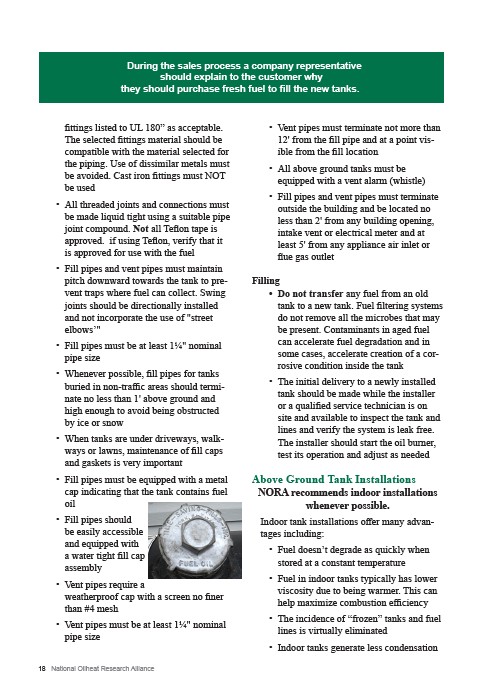
During the sales process a company representative
should explain to the customer why
they should purchase fresh fuel to fill the new tanks.
fittings listed to UL 180” as acceptable.
The selected fittings material should be
compatible with the material selected for
the piping. Use of dissimilar metals must
be avoided. Cast iron fittings must NOT
be used
• All threaded joints and connections must
be made liquid tight using a suitable pipe
joint compound. Not all Teflon tape is
approved. if using Teflon, verify that it
is approved for use with the fuel
• Fill pipes and vent pipes must maintain
pitch downward towards the tank to prevent
traps where fuel can collect. Swing
joints should be directionally installed
and not incorporate the use of "street
elbows’"
• Fill pipes must be at least 1¼" nominal
pipe size
• Whenever possible, fill pipes for tanks
buried in non-traffic areas should terminate
no less than 1' above ground and
high enough to avoid being obstructed
by ice or snow
• When tanks are under driveways, walkways
or lawns, maintenance of fill caps
and gaskets is very important
• Fill pipes must be equipped with a metal
cap indicating that the tank contains fuel
oil
• Fill pipes should
be easily accessible
and equipped with
a water tight fill cap
assembly
• Vent pipes require a
weatherproof cap with a screen no finer
than #4 mesh
• Vent pipes must be at least 1¼" nominal
pipe size
18 National Oilheat Research Alliance
• Vent pipes must terminate not more than
12' from the fill pipe and at a point visible
from the fill location
• All above ground tanks must be
equipped with a vent alarm (whistle)
• Fill pipes and vent pipes must terminate
outside the building and be located no
less than 2' from any building opening,
intake vent or electrical meter and at
least 5' from any appliance air inlet or
flue gas outlet
Filling
• Do not transfer any fuel from an old
tank to a new tank. Fuel filtering systems
do not remove all the microbes that may
be present. Contaminants in aged fuel
can accelerate fuel degradation and in
some cases, accelerate creation of a corrosive
condition inside the tank
• The initial delivery to a newly installed
tank should be made while the installer
or a qualified service technician is on
site and available to inspect the tank and
lines and verify the system is leak free.
The installer should start the oil burner,
test its operation and adjust as needed
Above Ground Tank Installations
NORA recommends indoor installations
whenever possible.
Indoor tank installations offer many advantages
including:
• Fuel doesn’t degrade as quickly when
stored at a constant temperature
• Fuel in indoor tanks typically has lower
viscosity due to being warmer. This can
help maximize combustion efficiency
• The incidence of “frozen” tanks and fuel
lines is virtually eliminated
• Indoor tanks generate less condensation